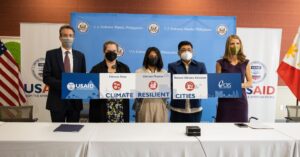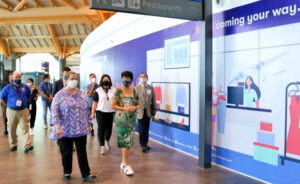The Philippine Disaster Resilience Foundation (PDRF)’s Project KoNeK conducted simulation exercises in three barangays in Quezon City to test their readiness for disasters. This was in partnership with the Quezon City Disaster Risk Reduction Management Office (QCDRRMO), Center for Disaster Preparedness (CDP), and the Philippine Geographical Society (PGS), and supported by the United States Agency for International Development, Bureau for Humanitarian Assistance (USAID-BHA).
Almost 80 local government officials from Barangays Bagumbayan, Talayan, and Doña Imelda participated in the simulation exercises on specific disasters to which these barangays are vulnerable such as fires and floods. Another exercise is scheduled for Barangay Commonwealth, focusing on their readiness for earthquakes.
Entitled “Barangay na Handa, Barangay na Ligtas,” each session aimed to assess the following: the level of knowledge of barangay officials, barangay responders, and disaster committee members of their Contingency Plan, the coordination of the local incident command with the local government and other stakeholders during emergencies, and the evacuation procedures and camp management of the barangays during disasters. These sessions were facilitated by disaster management experts from PDRF, PGS, and QCDRRMO.
“In the pursuit of the ever-elusive community resilience, the partnerships we formed with the Philippine Disaster Resilience Foundation and the Philippine Geographical Society emboldened the city government’s commitment to save people’s lives in the face of hazards and disasters,” said Bianca Perez, Research & Planning Section Chief of the Quezon City Disaster Risk Reduction Management Office.
“I thank these organizations for being our force multipliers in disaster risk management. They have helped us educate our communities in understanding their risks, equipped them to become more prepared, and guided them on recovering promptly after disasters.”
Project KoNeK or Komunidad at Negosyo Tungo sa Katatagan is an initiative of PDRF and USAID-BHA that aims to build the DRRM capabilities of local communities. Project KoNeK has three main components: strengthening community resilience, establishing continuity of operations, and developing public-private partnerships. The simulation exercise is one of the project’s many capacity-building activities, including evacuation camp management, barangay DRRM, contingency planning, and creating hazard maps.
“Project Konek is a great example of how to make our communities safer and better prepared for future emergencies,” said PDRF President Butch Meily.
Other notable Project KoNeK activities include the Public Service Continuity Planning program which has trained local government units and national government agencies all over the country on ensuring service delivery during a crisis and the support for the Department of Energy in developing the National Energy Contingency Plan, focusing on building energy resilience in case of major disasters.



